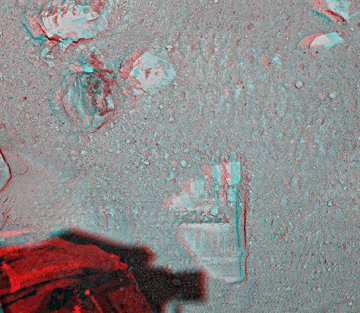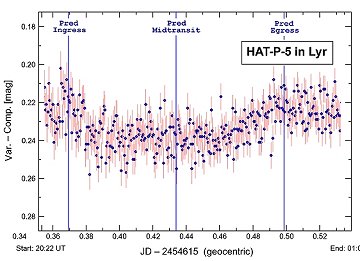| FLYBY ALERT! Space shuttle Discovery launched on May 31st. Get your flyby alerts from Space Weather PHONE | | | DOCKED: Space shuttle Discovery, laden with much-needed supplies and a new Japanese science lab, has docked to the International Space Station. The joined spaceships are bright and easy to see with the unaided eye as they sail among the stars of the night sky. Use our Simple Flybys tool to find out when to look. Sightings: #1, #2, #3, #4, #5, #6, #7, #8, #9. FIRST IMPRESSIONS: On Saturday, May 31st, Phoenix's 7.7-foot robotic arm reached out and touched Mars for the first time. Put on your 3D glasses and behold this stereo view of the first impression: 
Graphic artist Patrick Vantuyne of Belgium made this anaglyph by combining images from the left and right eyes of Phoenix's stereo camera. He calls the photo "Mars Yeti" because the mark made by the arm's scoop resembles a certain mysterious footprint. Soon, the robotic arm will begin digging into the soil and drawing samples back inside the lander for detailed analysis. Do the icy sands of Mars contain the stuff of life? Stay tuned! more 3D images from Mars: #1, #2. HOT JUPITER: Imagine fitting a planet the size of Jupiter deep inside the orbit of Mercury and having it circle the sun once every three dizzying days. Such a bizarre solar system does exist 1100 light years from Earth, in the constellation Lyra. The name of the G-type star is GSC 2634-1087; the name of the planet is HAT-P-5b, christened for the Hungarian-based HAT team of astronomers who discovered it in Oct. 2007. On May 28th, 2008, amateur astronomer Anthony Ayiomamitis of Athens, Greece, was monitoring the star when its "hot Jupiter" passed in front, temporarily blocking some of the star's light: 
"This light curve, which I made using my AP160 refractor, beautifully illustrates the 175-minute transit with its gradual dimming and brightening." The amazing thing is the scale of the dimming--"only 13 milli-magnitudes," says Ayiomamitis. "The star's magnitude changed from 11.950 before the planet intervened to 11.963 at mid-transit." Measuring such tiny changes requires mind-boggling skill--almost as mind-boggling as Jupiter stuffed inside Mercury's orbit and racing breakneck around the sun. It makes you wonder, what else is out there?
May 2008 Aurora Gallery
[Aurora Alerts] [Night-sky Cameras] | 
